Books I read in March
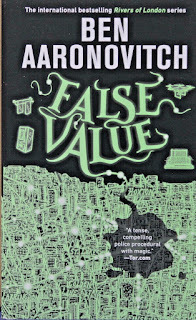
False Value Rivers of London Book 8 Ben Aaronovich B-
Gosh, anotherfantasy book. That said, I have been reading the Rivers of Londonseries since it first came out, a decade ago or so. I did, howeverfall behind for a time, as there was a time when there were no massmarket paperbacks to buy. I think that now I have read all the novelsup to this point. I know that I have not read the short stories.
The highlights ofthese urban fantasy books set, you guessed it, mostly in London, isAaronovich’s writing and first person point of view character,Peter Grant, a London policeman with magical powers. In additionthere are a cast of strange and wonderful characters, includinggoddess tied to the rivers that converge on the Thames in London. Thestories are set in our world, where magic exists, but is rare enoughthat most people are not aware of it.
This story is abouta secretive high-tech company developing an artificial intelligence,that already seems dated in 2023, with the advent of AI chat and artbots. As usual, I won’t go into the plot, except to say that it isconvulsed, and deliberately so. The first part of the story’s timeline is sliced and diced, telling the story out of chronologicalorder for no discernible reason that I can discover. Indeed, I haveno idea how long the story spans. And Aaronovich throws in a lot ofsub-plots, minor characters, and police procedural details that servemore to bump up the word count than advance the story. All of thisaccounts for the “-” behind the “B” rating, so you can seethat they were minor annoyances, especially the out of chronologicalorder telling of the story, and I still enjoyed the story despitethem. It was a better story than the one the proceeded it.
My other generalcomplaint is that the premise is that magic is so rare that it isunnoticed in our world, save for a small group of people. However, asthe series continues, magic plays such a large role in large scaleevents in these books, that it is unrealistic to expect me, at least,to believe that this is our world. If magic exists in our world, itis rare and known to an actual few, not the entire London policedepartment. I had the same complaint for the book I read last month,Fated. You can’t have it both ways; our familiar world with magicall but unknown, or a world were the existence of magic is widelyknow and as a result, the world would be very different. But that’sno doubt the writer in my outlook.
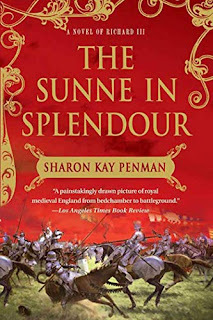
The Sunne inSplendour Sharon Kay Penman DNF 7% (page 71)
No doubt a perfectlyfine book, but not for me. I was looking for some historical fiction,and this one sounded pretty good. It’s about Richard III and theWar of the Roses. However, this book starts out with Richard as achild of seven, and to be perfectly honest, I am not interested inreading about children, unless I am reading to children. In this wayit covers history leading up to when Richard steps onto the world’sstage, but with 1233 pages, it clearly was going to take a while toget there.
My other complaintis my usual one – hopping between point of view characters. In whatI read of the story, we start with young Richard, move on to one ofhis older brothers, and after he is killed, on to Richard’s mother,at which point I called it a day.
My objection tojumping around in the heads of characters in general, is very simple:in my view, it makes them props rather than characters. Authors use them, and their thoughts, to tell what they want at any point inthe story, and when whey don't need them, they are just ciphers,pawns to move around. In these types of stories, the author is themain character, as they are the ones who play every role, jumpingform character to character, to speak every important line, thinkevery important thought. I want to be told a story by a person, aboutpeople, not sock puppets. Readers can get to know characters fromwhat the say and do, we don’t need to be in their head to knowthem. And not, when the author doesn’t want us to know what theyare thinking for whatever reason.
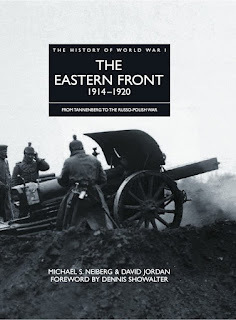
The Eastern Front1914 – 1920 By Michael S Neiberg & David Jordan B-
This is an overviewof World War One and the Russian Revolution, part of a series: “TheHistory of World War One.” As such is is a perfectly fine, wellwritten book. It includes maps and lots of photos, with many sidebarson different aspects of the war on the Eastern Front and thepersonalities involved in it. As I mentioned in my Waterloo Bookreview, military history without easy access to maps, is less thanideal. Here the maps were pretty general, and not adjacent to thetext, but that is the price you pay if you are too lazy to go outinto the cold and drive to the library for a paper book. As well asWorld War One, it covers the battles of the White Russians againstthe Bolsheviks, and briefly, the war between Poland and Russia. Theselater conflicts were very confusing in reality, and they remainconfusing in the book as well. Still, the book does the job it setout to do; give the reader an overview of World War One beyond thetrenches of the Western Front.
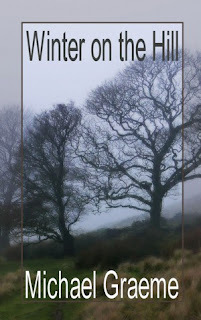
Winter on theHill by Michael Graeme C
Graeme writesintrospective novels of literary fiction. All three of the novelsI’ve read so far, are narrated by men of a certain age – ofsixty, plus or minus a few years – who find themselves inretirement a stranger in a strange land. They are single, lonely,usually rather bitter, if not angry, about not only their lives, butwhat has happened to the world in their lifetime. They are lookingfor something worthwhile to do with their rather empty lives. Withinthis narrative of contemplation, Graeme introduces characters thatchange the lives of his narrator. In this novel, it is a set ofmostly single women of a certain age who are members of a hiking clubthat he joins. Set in the Covid years in Britain, the story revolvesaround his relationships with several of those women, one of whom hastaken a vow of silence, and thus is very intriguing. It is very mucha slice of life story, not much of a romance, and in the end, not allthat satisfying of a story, as the key character, the woman whodoesn’t speak, doesn’t quite live up to her potential as acharacter, I think. We never quite get to know her, even as thenarrator spends more time with her. Maybe it’s just me, I likeromances, but unlike the first two Graeme books, Saving Grace,and the best of his that I’ve read, A Lone Tree Falls, havea strong genre mystery story that is wrapped within all the thoughtsof his introspective narrator. That strong mystery/genre story ismissing in this novel despite his attempts to suggest one. It ismostly introspective thoughts, and those get rather tedious.
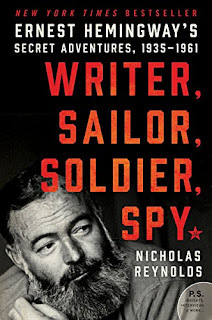
Writer, Sailor,Soldier, Spy Ernest Hemingway’s Secret Adventures 1935-1961 byNicolas Reynolds C
Non fiction. Thiscovers Hemingway’s life from about 1936 to his death in 1961 andfocuses on his ongoing fight against fascism, first in Spain and thenin World War 2. And documents his contacts and general approval ofthe Russians who were the only ones who were fighting fascists.Though he was never a formal agent of the communists, he had files inboth Moscow and Washington as a know lefty. It is a very detailedaccount of what he did and who he did it with reporting andoccasionally fighting in both Spain during their civil war, and thenin World War 2, where he used is fishing boat to patrol the watersoff of Cuba in order to locate German submarines, and then, landingwith the US Army’s Normandy invasion, and followed it on to theliberation of Paris. I found all of the details and characters a bit tedious, but that’s just me.
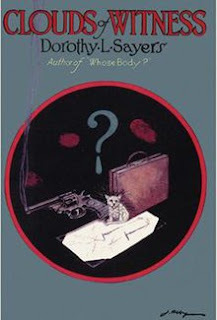
Clouds of Witness by Dorothy L Sayers C
My reading chair isalongside my wall of books. And the books most handy from the readingchair is my modest mystery story collection. This is a Lord PeterWimsey mystery. It has no doubt been on my bookshelves for half acentury. I may’ve read it back in the day. Or not. I seem toremember that I grew rather weary of Lord Peter Wimsey bright banter.In any case, I had no recollection of it, nor did reading it stir upany. In this book, Wimsey’s older brother is charged with murderand Wimsey must discover who actually did it, despite the silence ofhis brother. Sayers writes an intricate mystery, but I found itrather slow going, and never got caught up in the story or themystery. And there were several scenes that I though were a bit overthe top. I have several more Wimsey books on the shelf, but I won’tbe getting to them anytime soon.

The High Windowby Raymond Chandler A
I reached over andpicked up another mystery, and this was the one I picked up. RaymondChandler and P G Wodehouse where the two authors that I discovered inmy early 20’s that changed the way I looked on reading. After adecade of reading SF where stories, if not just far out ideas, werethe focus, I discovered that with Chandler and Wodehouse, writingbecame the focus. Never mind the story, their writing alone was theentertainment. It still is. If you like clever, witty, gritty, andmarvelously atmospheric writing, with deftly drawn characters andconvoluted plots, Chandler is your guy.
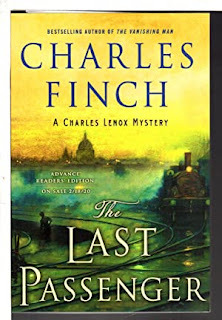
The LastPassenger - A Charles Lerox Mystery by Charles Finch C-
This is more or lessa cozy mystery set in London in 1855. It is the third prequel to along running series of Charles Lenox mysteries. It recounts how helearned his trade and lost his love. I found it to be an annoy book.It is written by an American in a contemporary style for acontemporary audience, and as such has almost no authentic feel. Abunch of Victorian era tropes are thrown in but from such a remote,modern distance, that they add no atmosphere to the story. In thisbook Finch was either trying to showcase his Wikipedia skills, oreducate his readers, since he tosses in all sorts of factoids intothe narrative. Things like brief bios of a historical characters, thehistory of the anti-slave movement in Britain, why the tobacco plantwas introduced in Europe, etc. None of which are necessary for thestory. But what bugged me the most was that he didn’t get the factsright that he shoved into the story.
The story involvesfind a mutilated body on a London and North Western Railroad traincarriage from Manchester in Paddington Station. He has his hero usehorse drawn dog carts to search along the track from PaddingtonStation, explaining that “the width between railroad tracks allacross England was exactly four feet eight and a half inches…because that was the width of a horse-drawn wagon.” and goes on toexplain how that came to be, adding at no extra cost, that was alsothe exact width for the war chariots of ancient Rome. Finch then hasus to believe that not only could a horse-drawn dog cart be pulledalong the top of the two rails without the wheels slipping off at anyspeed, but that they could do so without making any specialarrangements on two rail lines leading from Paddington Station –without being run over by approaching or departing trains. Even in1855 a station like Paddinton would have trains arriving anddeparting on numerous tracks. However, leaving that impossibilityaside, if Mr Finch had done his Wikipedia homework thoroughly, hewould’ve discovered that in 1855 the width of railroad tracks wasnot uniform across England. The Great Western Railroad operated onit’s own wide gauge tracks, those being a seven foot and onequarter inch gauge (I looked it up on Wikipedia). He would have alsodiscovered that the London terminal for the GWR was PaddingtonStation. If he had looked a little further into the Wikipedia entryfor the London and North Western Railroad, the train arriving inLondon from Manchester, he would have discovered it would havearrived in London at Euston Station, the L.A.N.W.’s Londonterminus. So why Paddington Station rather than Euston? I’ve noclue. A minor point, yes, but if you are going to stuff your storywith all sorts of extraneous “facts,” get them right.
I will not becontinuing on with this series.



